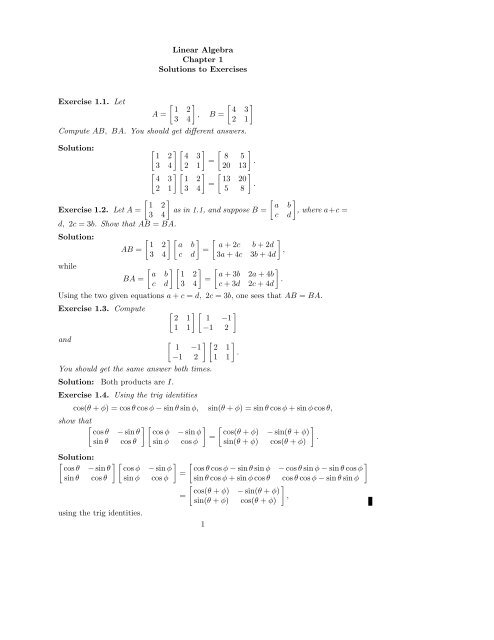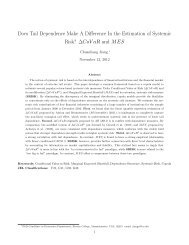Linear Algebra Chapter 1 Solutions to Exercises Exercise 1.1. Let A ...
Linear Algebra Chapter 1 Solutions to Exercises Exercise 1.1. Let A ...
Linear Algebra Chapter 1 Solutions to Exercises Exercise 1.1. Let A ...
You also want an ePaper? Increase the reach of your titles
YUMPU automatically turns print PDFs into web optimized ePapers that Google loves.
<strong>Linear</strong> <strong>Algebra</strong><br />
<strong>Chapter</strong> 1<br />
<strong>Solutions</strong> <strong>to</strong> <strong><strong>Exercise</strong>s</strong><br />
<strong>Exercise</strong> <strong>1.1.</strong> <strong>Let</strong><br />
A =<br />
[ ]<br />
1 2<br />
, B =<br />
3 4<br />
[ ]<br />
4 3<br />
2 1<br />
Compute AB, BA. You should get different answers.<br />
Solution: [ ] [ ] [ ]<br />
1 2 4 3 8 5<br />
= .<br />
3 4 2 1 20 13<br />
[ ] [ ] [ ]<br />
4 3 1 2 13 20<br />
= .<br />
2 1 3 4 5 8<br />
[ ]<br />
[ ]<br />
1 2<br />
a b<br />
<strong>Exercise</strong> 1.2. <strong>Let</strong> A = as in 1.1, and suppose B = , where a+c =<br />
3 4<br />
c d<br />
d, 2c = 3b. Show that AB = BA.<br />
Solution:<br />
while<br />
[ ] [ ] [ ]<br />
1 2 a b a + 2c b + 2d<br />
AB =<br />
=<br />
,<br />
3 4 c d 3a + 4c 3b + 4d<br />
[ ] [ ]<br />
a b 1 2<br />
BA =<br />
=<br />
c d 3 4<br />
[<br />
a + 3b 2a + 4b<br />
c + 3d 2c + 4d<br />
Using the two given equations a + c = d, 2c = 3b, one sees that AB = BA.<br />
<strong>Exercise</strong> 1.3. Compute [ ] [ ]<br />
2 1 1 −1<br />
1 1 −1 2<br />
and [<br />
1 −1<br />
−1 2<br />
You should get the same answer both times.<br />
Solution: Both products are I.<br />
<strong>Exercise</strong> 1.4. Using the trig identities<br />
] [ ]<br />
2 1<br />
.<br />
1 1<br />
cos(θ + φ) = cos θ cos φ − sin θ sin φ, sin(θ + φ) = sin θ cos φ + sin φ cos θ,<br />
]<br />
.<br />
show that [<br />
cos θ<br />
sin θ<br />
] [ ]<br />
− sin θ cos φ − sin φ<br />
=<br />
cos θ sin φ cos φ<br />
[ ]<br />
cos(θ + φ) − sin(θ + φ)<br />
.<br />
sin(θ + φ) cos(θ + φ)<br />
Solution:<br />
[ ] [ ] [ ]<br />
cos θ − sin θ cos φ − sin φ cos θ cos φ − sin θ sin φ − cos θ sin φ − sin θ cos φ<br />
=<br />
sin θ cos θ sin φ cos φ sin θ cos φ + sin φ cos θ cos θ cos φ − sin θ sin φ<br />
[ ]<br />
cos(θ + φ) − sin(θ + φ)<br />
=<br />
,<br />
sin(θ + φ) cos(θ + φ)<br />
using the trig identities.<br />
1
2<br />
<strong>Exercise</strong> 1.5. [ The powers ] of a matrix are computed as A 2 = AA, A 3 = AAA,<br />
0 −1<br />
etc. <strong>Let</strong> A = . Compute A<br />
1 −1<br />
2 , A 3 , A 4 , A 100 .<br />
Solution:<br />
A 2 =<br />
[ ]<br />
−1 1<br />
, A 3 = I, A 4 = A, A 100 = AA 99 = A(A 3 ) 33 = A(I) 33 = A.<br />
−1 0<br />
<strong>Exercise</strong> 1.6. Find the inverses of<br />
A =<br />
[ ]<br />
2 1<br />
, B =<br />
1 1<br />
[ ]<br />
0 −1<br />
, C =<br />
1 −1<br />
[ ]<br />
1 b<br />
.<br />
0 1<br />
Solution:<br />
A −1 =<br />
[ ]<br />
1 −1<br />
, B −1 =<br />
−1 2<br />
[<br />
−1<br />
]<br />
1<br />
−1 0<br />
C −1 =<br />
[ ]<br />
1 −b<br />
.<br />
0 1<br />
<strong>Exercise</strong> 1.7. <strong>Let</strong><br />
Show that<br />
[<br />
cos θ − sin θ<br />
A =<br />
sin θ cos θ<br />
]<br />
.<br />
[ ]<br />
A −1 cos(−θ) − sin(−θ)<br />
=<br />
.<br />
sin(−θ) cos(−θ)<br />
Solution:<br />
First note that det A = sin 2 θ + cos 2 θ = 1, so<br />
A −1 = 1 [<br />
cos θ sin θ<br />
1 − sin θ cos θ<br />
]<br />
.<br />
To get the desired expression for A −1 , recall that cos θ is an even function and sin θ<br />
is an odd function.<br />
<strong>Exercise</strong> 1.8. There are only two numbers that are their own inverses, namely 1<br />
and -1. Find five matrices that are their own inverses.<br />
Solution:<br />
There are infinitely many such matrices, besides the obvious ones like<br />
[ ]<br />
±1 0<br />
.<br />
0 ±1<br />
For example, take any nonzero number b, and consider the matrices<br />
[ ]<br />
−1 b<br />
,<br />
0 1<br />
[<br />
0 b<br />
1<br />
b<br />
0<br />
]<br />
.
3<br />
<strong>Exercise</strong> 1.9. Find a matrix A having at least one nonzero entry, such that<br />
A 2 =<br />
[ ]<br />
0 0<br />
.<br />
0 0<br />
[ ]<br />
1 0<br />
Solution: Any matrix of the form works. The most general such matrix<br />
0 1<br />
(you only have <strong>to</strong> find one of them) is<br />
[ ]<br />
a b<br />
, where a 2 + bc = 0.<br />
c −a<br />
<strong>Exercise</strong> 1.10. <strong>Let</strong><br />
[ ] [ ] [ ]<br />
a b<br />
e f<br />
i j<br />
A = , B = , C = .<br />
c d<br />
g h<br />
k l<br />
Show that (AB)C = A(BC).<br />
Solution:<br />
We compute<br />
[ ] [ ]<br />
ae + bg af + bh i j<br />
(AB)C =<br />
ce + dg cf + dh k l<br />
[ ]<br />
(ae + bg)i + (af + bh)k (ae + bg)j + (af + bh)l<br />
=<br />
(ce + dg)i + (cf + dh)k (ce + dg)j + (cf + dh)l<br />
[ ]<br />
a(ei + fk) + b(gi + hk) a(ej + fl) + b(gj + hl)<br />
=<br />
c(ei + fk) + d(gi + hk) c(ej + fl) + d(gj + hl)<br />
[ ] [ ]<br />
a b ei + fk ej + fl<br />
=<br />
c d gi + hk gj + hl<br />
= A(BC).

















